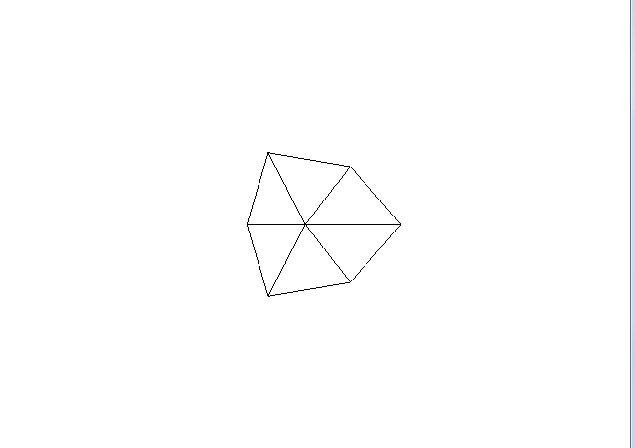通常,如果我们需要画一个立方体的话需要做什么?可以想象一下我们需要如下叫几个步骤:
(1). 得到一个画布
(2). 准备好需要画相关的点
(3). 准备好摄像机
(4).用2维图像来表现3维效果
(5). 连接这些点 画出一个立方体
1. 得到画布
D3D中, 所有画图的操作都是在IDirect3DDevice9 中的, 所以我们就可以
这样声明: IDirect3DDevice9* Device = 0;
出生化之(略)
2. 准备好相关的点
D3D中, 花点用了两个Buffer, vertex buffer 用来保存相关的点的值,
index buffer 用来保存点之间连接的索引。
首先我们可以这样声明一个结构体:
struct Vertex
{
Vertex(){}
Vertex(float x, float y, float z)
{
m_x = x;
m_y = y;
m_z = z;
}
float m_x, m_y, m_z;
static const DWORD FVF;
};
const DWORD Vertex::FVF = D3DFVF_XYZ;
然后利用 CreateVertexBuffer 和 CreateIndexBuffer 创建 vertex buffer 和 index buffer
Device->CreateVertexBuffer(
8 * sizeof(Vertex),
D3DUSAGE_WRITEONLY,
Vertex::FVF,
D3DPOOL_MANAGED,
&VB,
0);
Device->CreateIndexBuffer(
36 * sizeof(WORD),
D3DUSAGE_WRITEONLY,
D3DFMT_INDEX16,
D3DPOOL_MANAGED,
&IB,
0);
最后填充vertex buffer 和 index buffer。
我们得到了相关的vertex buffer 和index buffer之后, 我们就去为这些点赋值。
我们用Lock函数得到相应的内存位置,复制完成以后用Unlock 释放.
Vertex* vertices;
VB->Lock(0, 0, (void**)&vertices, 0);
// vertices of a unit cube
vertices[0] = Vertex(-1.0f, -1.0f, -1.0f);
vertices[1] = Vertex(-1.0f, 1.0f, -1.0f);
vertices[2] = Vertex( 1.0f, 1.0f, -1.0f);
vertices[3] = Vertex( 1.0f, -1.0f, -1.0f);
vertices[4] = Vertex(-1.0f, -1.0f, 1.0f);
vertices[5] = Vertex(-1.0f, 1.0f, 1.0f);
vertices[6] = Vertex( 1.0f, 1.0f, 1.0f);
vertices[7] = Vertex( 1.0f, -1.0f, 1.0f);
VB->Unlock();
// define the triangles of the cube:
WORD* indices = 0;
IB->Lock(0, 0, (void**)&indices, 0);
// front side
indices[0] = 0; indices[1] = 1; indices[2] = 2;
indices[3] = 0; indices[4] = 2; indices[5] = 3;
// back side
indices[6] = 4; indices[7] = 6; indices[8] = 5;
indices[9] = 4; indices[10] = 7; indices[11] = 6;
// left side
indices[12] = 4; indices[13] = 5; indices[14] = 1;
indices[15] = 4; indices[16] = 1; indices[17] = 0;
// right side
indices[18] = 3; indices[19] = 2; indices[20] = 6;
indices[21] = 3; indices[22] = 6; indices[23] = 7;
// top
indices[24] = 1; indices[25] = 5; indices[26] = 6;
indices[27] = 1; indices[28] = 6; indices[29] = 2;
// bottom
indices[30] = 4; indices[31] = 0; indices[32] = 3;
indices[33] = 4; indices[34] = 3; indices[35] = 7;
IB->Unlock();
3. 准备好摄像机
D3DXVECTOR3 position(0.0f, 0.0f, -5.0f);
D3DXVECTOR3 target(0.0f, 0.0f, 0.0f);
D3DXVECTOR3 up(0.0f, 1.0f, 0.0f);
D3DXMATRIX V;
D3DXMatrixLookAtLH(&V, &position, &target, &up);
Device->SetTransform(D3DTS_VIEW, &V);
4. 用2维图像来表现3维效果
D3DXMATRIX proj;
D3DXMatrixPerspectiveFovLH(
&proj,
D3DX_PI * 0.5f, // 90 - degree
(float)Width / (float)Height,
1.0f,
1000.0f);
Device->SetTransform(D3DTS_PROJECTION, &proj);
设置渲染模式:
Device->SetRenderState(D3DRS_FILLMODE, D3DFILL_WIREFRAME);
5. 开始画了
当一切准备就绪之后就可以用vertex buffer 和index buf 中的内容画三角形了。
但是要画东西出来却需要遵循一下三步:
(1).把 vertex buffer 中的内容放到一个 stream 中, 这是stream会最终把几何图型渲染成为图像。
相应的函数是SetStreamSource
(2).设置点的格式, 利用SetFVF函数
(3).设置 index buffer, 调用的是函数 SetIndices
在开始之前, 我们把屏幕背景填充成白色:
Device->Clear(0, 0, D3DCLEAR_TARGET | D3DCLEAR_ZBUFFER, 0xffffffff, 1.0f, 0);
然后就开始画 立方体:
Device->BeginScene();
Device->SetStreamSource(0, VB, 0, sizeof(Vertex));
Device->SetIndices(IB);
Device->SetFVF(Vertex::FVF);
// Draw cube.
Device->DrawIndexedPrimitive(D3DPT_TRIANGLELIST, 0, 0, 8, 0, 12);
Device->EndScene();
Device->Present(0, 0, 0, 0);
好了这样一个简单的立方体就出来了。
























 1505
1505

 被折叠的 条评论
为什么被折叠?
被折叠的 条评论
为什么被折叠?








